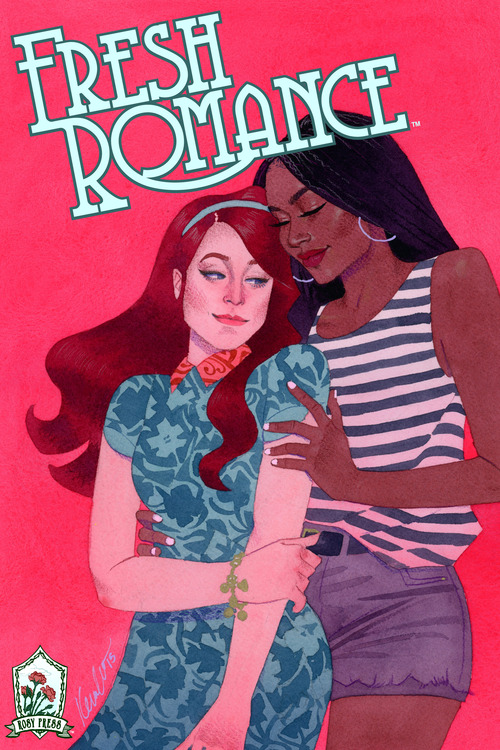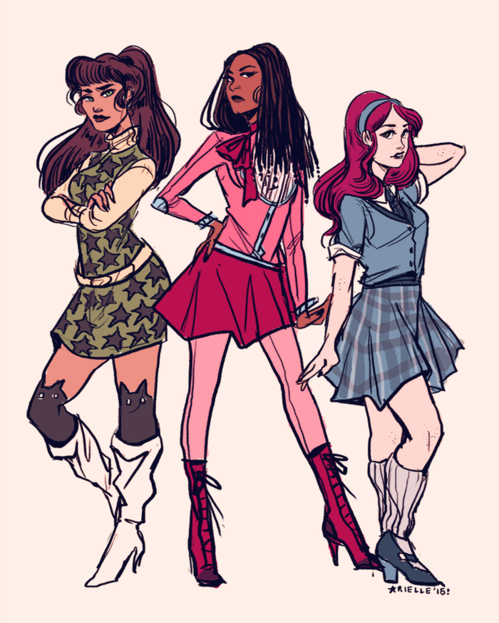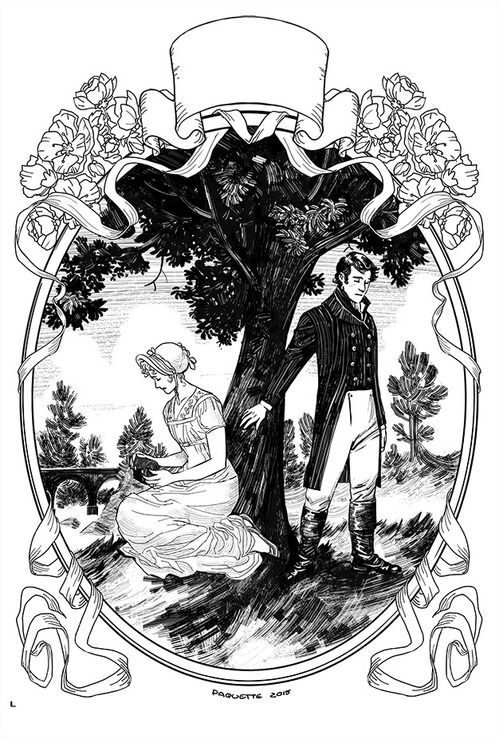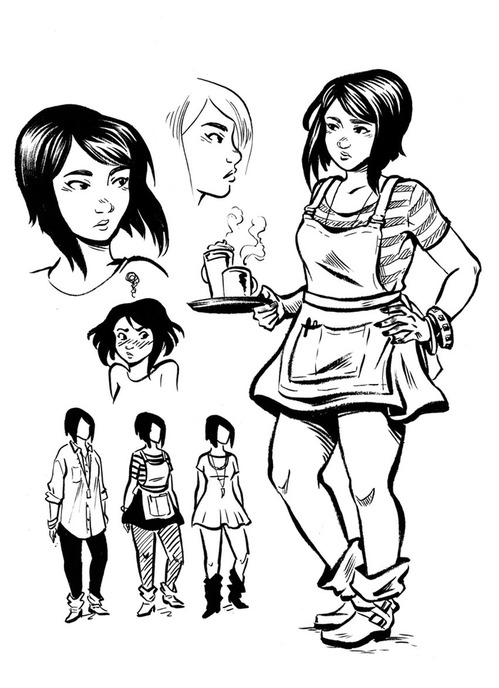The New Fresh Romance Kickstarter Seeks to Reintroduce a Lost Comic Genre to a New Audience
Books FeaturesJanelle Asselin has a wonderful idea, and she happens to live in a time when a good idea combined with good marketing has an excellent chance of coming to fruition. The longtime DC editor and current editor of Comics Alliance is trying to revive the romance comic genre with an all-digital anthology book called Fresh Romance; its funding campaign launched yesterday on Kickstarter and, as of right now, has met more than 2/3rds of its goal.
The first issue will feature stories created by Kate Leth, Arielle Jovellanos and Amanda Scurti (a queer high school romance); Sarah Vaughn and Sarah Winifred Searle (a Regency-era romance); and Sarah Kuhn, Sally Jane Thompson and Savanna Ganucheau (a romance featuring a matchmaker barista). The goal is for the book to release monthly with three stories per issue, bringing new life not only to the romance genre, but to the regular anthology format as well. It’ll be available through comiXology and other sources, with compilations planned should it succeed.
In addition, the creators behind the anthology will offer their very special take on the letters section, answering romantic queries from readers submitted to [email protected]. Answers will be published on Paste as well as in the first issue.
![]()
But, ultimately, what’s the big idea? Why now? Why Asselin? And do you have to be named Sarah to contribute? (Spoiler: No.) Asselin took the time to exchange emails with us to answer our questions.
Paste: What made you decide the time was right for a new romance comic? Who’s your audience?
Janelle Asselin: Our industry is really broadening right now in terms of what genres and audiences are being supported, so it seems like a great time to make sure one of those genres that’s being brought into this expanding market is one that most often appeals to women. Manga has been doing it for decades with great success, and I think American comics are due for romance comics to come back as well. Really, we’re trying to make romance comics for everyone, but certainly our focus is on women as readers, especially women 18-35.
Paste: How did you pick the first crop of authors?
Asselin: Some of them I already knew, and so was aware they had an interest in the romance genre, and others I found via research. I write a column for ComicsAlliance.com called “Hire This Woman” where I feature up-and-coming women comics creators, and so I have a long list of talented people that’s always easily accessible when I need to hire people. I also kept an eye toward making sure I brought in people with diverse perspectives and kinds of stories they wanted to tell. I didn’t want Fresh Romance to be full of all the same kinds of comics and comics creators.
Paste: If the Kickstarter succeeds and the book moves forward, do you have others in mind you’d like to contribute?
Asselin: Absolutely. Right now we have comics creators lined up and ready to go on future stories as soon as we see how the Kickstarter does. Some of them are pretty big names, too.
Paste: Is it important to you to keep the contributors largely female?
Asselin: It’s important to me that more than half of our contributors at any given time are women, but there are men working on Fresh Romance. Since I recruited this first round myself, it was a lot of finding people I knew would be interested in romance comics, but when we open the magazine up to submissions I imagine we’ll see an even broader range of contributors. Like I said before, I am very interested in publishing diverse perspectives and you don’t get that by only publishing one gender. Still, a big part of why I’m doing this is to help bring more women into the industry, and so having a woman-friendly magazine is very important to me.
**Paste: Why hasn’t anyone done this before? Manga has, but is it just that the big publishers have ignored their female audience for so long, and the indies don’t want to confine themselves to genre work?
Asselin: I think you hit the nail on the head—in American comics, you find publishers who either focus on just one genre in the form of superhero comics, or you find publishers who have no specific genre focus at all. It’s also been difficult to convince people in comics that women were a viable audience, although recent research showing women 18-25 being the fastest growing demographic in comics has certainly started to shift that. It’s a risk to take a genre that’s traditionally been aimed at women and put it into a medium that’s been male-dominated for decades. But it’s a risk I feel is worth taking.
Paste: So why Kickstarter as opposed to trying to convince the big publishers to put out a book like this? More creative control? Giving the potential fanbase a sense of ownership? It does kind of seem to be the new place to fund comics.
Asselin: The biggest reason is that Fresh Romance and its launch is tied to the launch of my own publishing company, [Rosy Press]. I’ve wanted to have my own comics publishing company for, well, years now, as I wanted to make the kind of comics that I believe is currently underserved by the comics market. If I were working at a larger publisher, sure the project would have additional resources that a small publisher just starting out doesn’t have, but there would be tradeoffs as well. I wanted to give myself more creative freedom and, at the same time, offer that creative freedom to any creators who work with me. Kickstarter offers the flexibility to fund creative endeavors without compromise and I think that’s really important for a project like this that deviates from what’s been standard in comics for so long.
Paste: Back in the day, when Joe Simon and Jack Kirby were doing romance comics, the genre attracted a lot of big names and a lot of artists who also focused on superheroes. Do you think there’s any chance of that happening again? Or is the divide between the capes/tights world and “other comics” too big?
Asselin: I don’t want to spoil our future announcements, but I will say that some of the future announcements I have up my sleeve are big-name creators who have worked or still are working at Marvel and DC. Our first three cover artists—Kevin Wada, Yanick Paquette and Marguerite Sauvage—have all worked at Marvel and/or DC. That’s also the world where I have the majority of my contacts, thanks to my stint at DC. So I was really pleased that when I started reaching out to some people I knew via DC, that many of them responded with “I’ve always wanted to [write/draw/etc.] a romance comic! Yes!” I think the divide is not with the creators but with what each publisher chooses to focus on.
At the same time, I think that while those big-name creators defined the early days of romance comics and probably brought more eyes, they were also almost entirely men, and part of the reason the genre eventually died is that it couldn’t keep up with the times or what girls and women actually wanted to read in a romance comic. We feel no need to be married to bringing in “big names” unless they are actually passionate about telling romance stories and understand the kind of audience we want to attract. These are romance comics for a new era, and our entire focus is on doing that right.
Paste: All-digital also seems like a smart move to attract female readers, who, from everything I’ve read, make up a larger proportion of consumers for digital books than for print. It also makes sense from the standpoint of cutting down costs. Did anything else go into that decision? Do you think it means the book will attract less attention? More? No difference?
Asselin: Those were both absolutely big factors. Also, growth in romance novels has been huge in digital—a lot of factors go into that, but at least some of it is that they’re generally quick reads, and reading on a tablet or ereader offers some discretion over what is being read. Another reason for me was that traditional comic shop distribution is pretty daunting for a new publisher—there are order minimums and trying to stand out in a giant catalog of new books every month, just to start.
Ultimately, though, the biggest factor was that I really wanted the magazine to straddle all publishing worlds: traditional publishing, comics, even magazines. Selling via comiXology and our own website means that we can reach beyond the comics audience while also not leaving that audience behind.
We might miss out on some of the attention from the main segment of the comics industry that is pretty focused on the monthly print comics that come to comic shops, but I think it will also make us more accessible to people who might not want to go to or know how to find a comic shop.
Paste: It’s not just that romance as a genre kind of disappeared from comics. It’s also that the kind of regular anthology publication fell by the wayside (special issues aside). What do you think contributed to that change? And do you think you can help bring it back?
Asselin: I think the rise of comic creators with their own fanbases led to comics publishers wanting to give those creators more space to tell their stories each month. It’s not a bad thing that our industry started to value the actual creative people creating the stories more than they did in the early days! But I think no matter what the profile of the creators, an ongoing anthology title has a lot to offer. One of the best is that creators who need more time, have a day job or work on other comics don’t have to feel taxed by also being part of a monthly publishing schedule. But unlike a one-time anthology, it offers regular income and work for many of the creators as well, which also shows other publishers that they’re reliable for more than a one-off story.
In terms of readers, I think it offers a diverse set of stories that can still be complex or ongoing. If you don’t like one of the stories, there are others for you. Change is constant in a monthly anthology magazine, which I think is really fun and makes every issue interesting.
I do hope to see more American publishers taking chances on anthologies. DC has been doing some digital anthologies like Sensation Comics that tend to get a solid critical response, and I think that continuing to talk about the broad range of things you can do with a consistent publishing schedule AND a varied set of creative teams will lead more people to give it a try.




